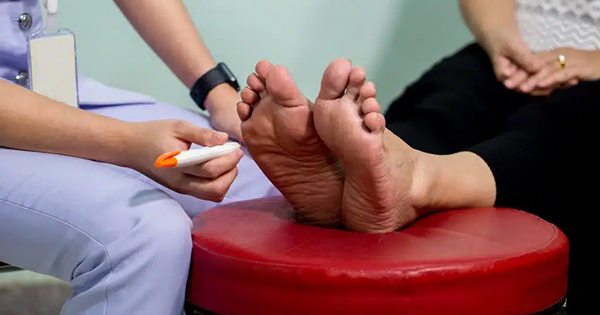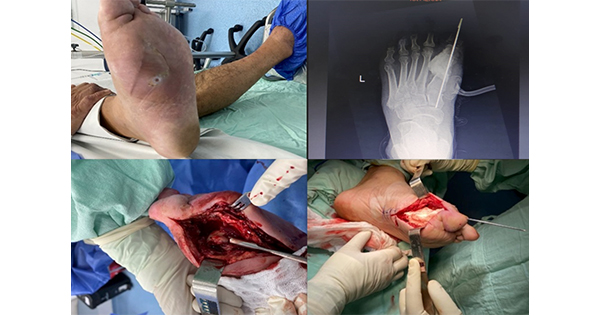Foot ulcers are one of the most common predisposing factors to minor or major lower-limb extremity amputation in people with diabetes (Larsson and Apelqvist, 1995). Thorough assessment must be undertaken to ascertain the aetiology/ies that predispose to the development of that ulcer to enable a suitable treatment and management plan to be implemented to optimise regression and healing. This assessment should result in the ulcer being classified in a simple manner to ensure that all members of the multidisciplinary team understand the classification, what it means and direct the appropriate ongoing treatment and management plan. The initial assessment should take into account all the main predisposing causes, including neuropathy, peripheral arterial occlusive disease, as well as infection and depth.
It has been known for decades that poor outcomes are often associated with deeper wounds, increased severity of infection and the presence peripheral vascular disease (Pratt, 1965; Williams et al, 1974; LoGerfo and Coffman, 1984; Apelqvist et al, 1989; Reiber et al, 1992; Jeffcoate et al, 1993). This is why it is imperative that any system adopted, especially on a national basis, takes into account all of these factors.
There are many diabetic foot ulcer (DFU) classification systems, all with their own merits. Their description and use have been well described in the literature (Lavery et al, 1996; Oyibo et al, 2001; Monteiro-Soares et al, 2014).
A classification system for Scotland
It was decided to assess and implement one of the proven DFU classification systems across Scotland. The Scottish Diabetes Foot Action Group and Scottish Care Information – Diabetes (SCI-Diabetes) team collaborated to decide which system would be best. A working group was established to discuss the merits or otherwise of the various classification systems.
Systems assessed
Wagner classification system
The Wagner classification system (Table 1), was developed in the 1970s (Wagner, 1981). The original system had six grades of lesions, but grade 0 refers to intact skin and is rarely used in clinical practice. The first three ulcer grades (1–3) are based on the physical depth of the lesion in and through the soft tissues of the foot. Wagner grades 4 and 5 are based on the extent of gangrene in the foot. It is clear from the newer classifications that Wagner’s system does not adequately address all DFUs and infections. Only grade 3 infers infection, and then only indirectly. Even as a surgical tool, the system is limited in its ability to identify and describe vascular disease as an independent risk factor for poor outcomes. In addition, superficial wounds that are infected or have a vascular component without gangrene cannot be classified separately by this system. For these reasons, the National Institute for Health and Care Excellence (NICE) 2015 guideline does not recommend using the Wagner classification system to assess DFUs.
University of Texas wound classification system
This system, usually shortened to the Texas classification, uses four grades based on the relative depth of the ulcer (Table 2). The grades are modified by the presence of infection (stage B), ischaemia (stage C) or both (stage D) (Lavery et al 1996). A wound grade and stage are used to categorise wounds by severity, starting with grade 0, representing a pre- or post-ulcerative site, to 3, where a bone or joint is involved. Within each grade there are four stages: non-ischaemic clean wounds (A), non-ischaemic infected wounds (B), ischaemic wounds (C) and infected ischaemic wounds (D).
This system has been validated and is generally predictive of outcome, since increasing grades and stages of wounds are less likely to heal without revascularisation or amputation. It is now widely used in many clinical trials and diabetic foot centres (Oyibo et al, 2001: Monteiro-Soares et al, 2014).
PEDIS classification system
The PEDIS classification system was developed by the International Working Group of the Diabetic Foot and takes into account the Perfusion, Extent, Depth, Infection and Sensation (PEDIS) of a foot wound (Table 3). It encompasses relevant variables that contribute to the outcome of DFUs and has the capacity to predict the outcome (Schaper, 2004). The PEDIS classification system was developed primarily for research, anticipating healthcare costs and comparing patient subgroups, but has not yet been validated in clinical practice regarding prognosis (Karthikesalingam et al, 2010).
SINBAD classification system
The system takes into account the Site, Ischaemia, Neuropathy, Bacterial Infection and Depth, hence the acronym SINBAD. The components of the classification (Table 4), can be added together to produce a score of between 0 and 6 (Ince et al, 2008).
Selecting a system
Appropriate DFU care requires a clear, descriptive classification system that may be used to direct appropriate therapy and possibly predict outcome. Initial classification on first presentation for treatment should only be applied once based on the initial characteristics of the ulcer to enable clear audit of treatment plans and outcomes (Young and Stang, 2018). There are positive and negative aspects to the four main DFU classification systems currently in use (Table 5) (Wounds International, 2013). The Texas classification system requires the clinician to evaluate wound depth, the presence of infection, and peripheral arterial occlusive disease ensuring a comprehensive wound assessment (Figure 1).
The description of a DFU differs from initial classification as it applies to the point in time at which the ulcer was described. Descriptive terms can, however, prompt adjustments to treatment (Young and Stang, 2018).
Following lengthy working group discussions, it was decided that the most clinically-appropriate system to adopt across Scotland was the Texas classification system because:
- It was the most widely used system in Scotland at that time
- It was simple
- It had been validated as clinically-relevant to outcomes in the diabetic foot
- It had a strong visual clinical application, so it was easy to understand.
Although the Texas system was widely used by podiatrists treating and managing the diabetic foot, anecdotally, it was not always used by nursing colleagues. Ideally, this system will be used by all participants involved in the multidisciplinary team.
The goal of using and adopting this system in Scotland is to improve communication between all disciplines involved in patients’ care. This will hopefully lead to a less complex, more predictable treatment course and, ultimately improved clinical outcomes.
SCI-Diabetes Ulcer Management System
The SCI-Diabetes team developed the comprehensive online Ulcer Management System (UMS), in order to standardise DFU assessment and records and facilitate auditing across Scotland. The UMS is the national system for recording DFU treatment and management and is widely used in practice. When recording an ulcer there are only three mandatory fields that require completion: date of ulcer onset, location and Texas score (Figure 2 — see highlighted in red). Other clinical markers can be recorded, such as infection, presence of osteomyelitis, temperature difference and measurements), any photographs taken and treatment (debridement, type, dressings, plus any additional notes). The initial classification is recorded and remains unchanged in the patient’s record (Figure 3), however, a current Texas score is added to the history each time the patient is treated by a multidisciplinary team member. The UMS can, therefore, be used as an audit tool to relate outcomes to initial Texas classification level.
The UMS is also a valuable treatment and management tool. It enables the Texas classification to be recorded in the written clinical notes and assigned to each treatment episode, in order to describe the ulcer at that precise time and, therefore, accurately describes any deterioration or improvement of the ulcer as treatment progresses. This is purely as a descriptor of the ulcer at the time of treatment and does not affect the initial Texas classification, which is used as an audit tool when predicting outcomes.
Creating a final outcome
When the treatment plan reaches its final outcome this can be easily and simply recorded on the system. This only requires the completion of one mandatory field (Figure 3 — see highlighted in red), which records the actual clinical outcome. All other data relating to onset date, final outcome date and location of the original ulcer are all automatically populated by the system.
Conclusion
Having reviewed the four main DFU classification systems, it was decided to adopt the Texas system across Scotland as it has been validated, is easy to understand and use. Texas scores are captured by the SCI-Diabetes UMS and can be audited to determine the success of DFU treatments, which are directed by scores, over time. Therefore, classification will increase standards of care and, ultimately, fewer amputations should improve outcomes for patients.





